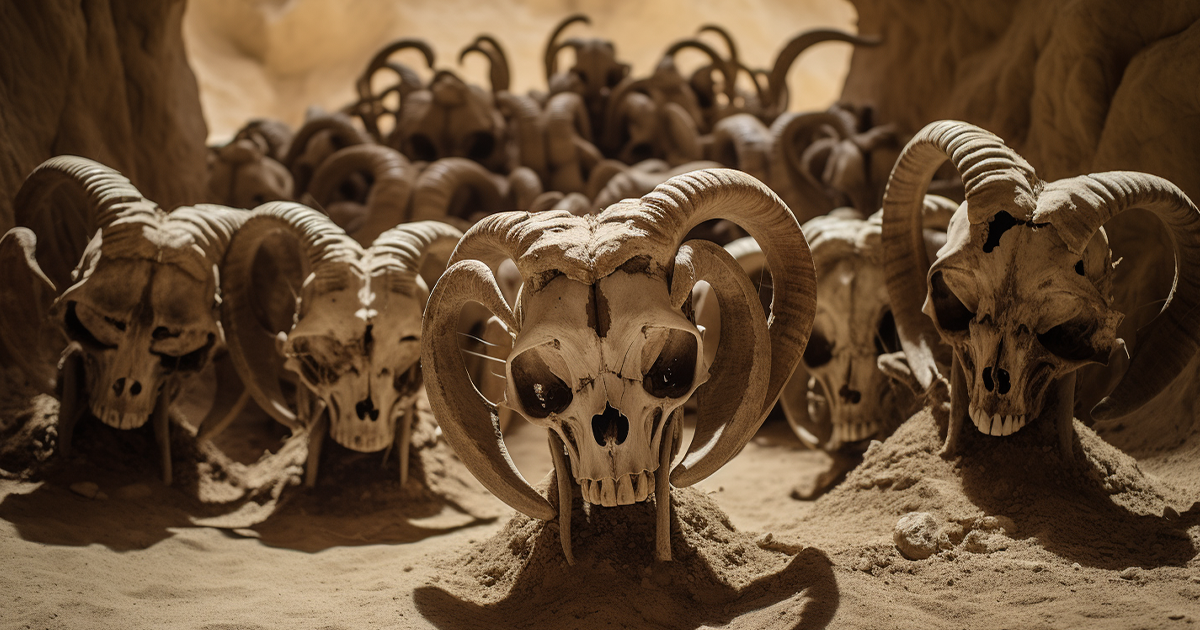Nestled beneath the eternal sands of ancient Egypt rests a domain veiled in enigma and puzzles, beckoning those in pursuit of unraveling its mysterious history. Aidas, an extensive temple complex standing for more than 5500 years, has enchanted archaeologists and history aficionados with its secrets and mysteries. In 2023, a team from New York University made a startling discovery that left the world astounded.
As archaeologists brushed away the centuries-old sand at Aidas, they unearthed an astonishing find – a collection of mummified ram skulls. What began as a mere uncovering turned into a revelation as a grand total of 2,000 ram skulls emerged, meticulously arranged side by side. These were not mere remnants but held profound significance as sacred relics.
The query arises – what drove individuals to mummify and entomb 2,000 ram skulls together? The answer may be entwined with the era of Pharaoh Ramses II, also known as Ramses the Great, who oversaw the construction of the Aidas temple complex. It is speculated that these ram skulls were interred as an enduring homage, a millennium after his reign.

The astounding revelation poses another mysterious question – what happened to the rest of the Rams? Unlike other mummified creatures in ancient Egypt, only the skulls of these Rams were meticulously preserved, veiling their bodies in secrecy.
The enigma of Aidas resonates through Egypt’s archaeological history. Over a century and a half ago, French archaeologist AUST Marette stumbled upon an equally perplexing collection of remains, albeit intact.
Marette’s exploration led him to Sakara, known locally as the “monsters’ cage.” Positioned just ten miles south of the majestic pyramids of Giza, this site held a unique reputation among indigenous Bedouin tribes, being viewed as a burial ground like no other.
While delving into the area, Marette came across a series of chambers housing gigantic sarcophagi. There were twenty-four in total, each measuring an impressive 12x6x6 feet, with lids weighing a staggering 40,000 pounds. The enormity of these coffins raised the question – what was their purpose, and who or what were they guarding against?
The essence of this enigma lies with the revered Apis bulls, massive creatures weighing 1300 pounds, revered as intermediaries between humans and the divine realm. Playing a vital role in elaborate religious rites dating back to 3000 BCE, each sarcophagus bore inscriptions in ancient Egyptian hieroglyphs denoting the final resting places of the Apis bulls. Hence, the locals’ belief in the “cage of monsters.”
However, not all occupants of these grand coffins rested undisturbed. Marette encountered one sarcophagus showing signs of tampering. Did the monsters escape, or did a daring individual attempt to plunder its contents? The answer remains as enigmatic as the numerous other unsolved puzzles of Egypt.
In the realm of archaeology, one enigma often begets another, weaving a complex web of unanswered mysteries. The wonders of Aidas and the “monsters’ cage” at Sakara stand as poignant reminders that Egypt’s sands harbor not only the grandeur of ancient civilizations but also the alluring enigmas that continue to captivate our intellect. As we delve deeper into antiquity, we must acknowledge that certain mysteries may perpetually evade our understanding.
